Understanding Plastic Stabilizers Key Additives for Enhanced Performance
Plastic stabilizers play a crucial role in the manufacturing and application of plastic materials, ensuring their longevity, durability, and performance across various environments. As the demand for high-quality plastics increases, so does the importance of stabilizers, which help combat degradation caused by environmental factors such as heat, UV radiation, and oxidation. This article delves into the significance of plastic stabilizers, their types, mechanisms, and applications in everyday life.
What Are Plastic Stabilizers?
Plastic stabilizers are additives used in plastic formulations to enhance the stability and performance of plastic products. These compounds work to prevent or reduce the degradation of polymers during processing and throughout their service life. They come in various forms, including heat stabilizers, UV stabilizers, antioxidants, and impact modifiers, each serving a specific purpose within the plastic matrix.
Types of Plastic Stabilizers
1. Heat Stabilizers These are vital for thermoplastic materials, as they help maintain the integrity of the polymer matrix when exposed to high temperatures during processing. Common heat stabilizers include metal soaps, phosphites, and phenolic compounds. They inhibit the breakdown of polymer chains that can occur when plastics are subjected to elevated temperatures, thus preventing discoloration and loss of mechanical properties.
2. UV Stabilizers Ultraviolet radiation can cause significant damage to plastics, leading to discoloration and brittleness. UV stabilizers, often based on benzotriazole or hindered amine light stabilizers (HALS), absorb UV light and convert it into harmless heat, thus protecting the polymer from photodegradation. These stabilizers are essential for outdoor applications, such as in construction materials or automotive parts exposed to sunlight.
3. Antioxidants Oxygen exposure can lead to oxidative degradation of plastics, affecting their physical properties and appearance. Antioxidants work by intercepting free radicals before they cause damage to the polymer chains. They come in various forms, including primary antioxidants (which offer immediate protection) and secondary antioxidants (which regenerate primary antioxidants over time). Common examples include hindered phenols and phosphites.
plastic stabilizers

4. Impact Modifiers While not traditional stabilizers, impact modifiers play a crucial role in enhancing the ductility and toughness of brittle plastics. By improving impact resistance, these additives allow plastics to better withstand mechanical stresses without cracking. This makes them critical in applications such as automotive components and consumer goods.
Mechanisms of Action
Plastic stabilizers act through various mechanisms, depending on their type and purpose. They may scavenge harmful free radicals, absorb harmful radiation, or promote cross-linking within the polymer matrix to enhance stability. By doing so, they can significantly prolong the life of plastic products and maintain their mechanical properties over time. For instance, during thermal processing, heat stabilizers create a protective environment for the polymer, reducing the rate of thermal degradation.
Applications in Everyday Life
Plastic stabilizers find applications across numerous industries, including automotive, construction, packaging, electronics, and consumer goods. For example
- Automotive Industry Stabilizers help protect car components, such as dashboards and bumpers, from UV radiation and temperature fluctuations, ensuring they maintain their appearance and functionality over time. - Construction Materials Plastics used in roofing, siding, and windows often incorporate UV and heat stabilizers to withstand harsh weather conditions, improving their lifespan and performance. - Consumer Products From toys to kitchenware, stabilizers ensure that plastic items remain safe, durable, and visually appealing throughout their intended use.
Conclusion
In summary, plastic stabilizers are essential additives that significantly enhance the performance and longevity of plastic materials. By mitigating degradation from environmental exposure, they play a pivotal role in various industries and everyday products. As innovation in material science continues to evolve, the development of new and improved stabilizers will be vital in meeting the growing demands for high-performance plastics. Understanding these compounds and their functions allows manufacturers to create more resilient products, ultimately leading to reduced waste and improved sustainability within the plastics industry.

